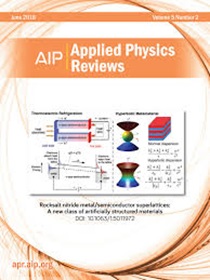Conceptual unification of mechanism-guided catalyst design for CO2 conversion to C1 products in thermal and plasma catalysis
IF 11.9
1区 物理与天体物理
Q1 PHYSICS, APPLIED
引用次数: 0
Abstract
Carbon dioxide (CO2) reduction to value-added chemicals for sustainable and clean energy is hindered by its considerable ionization potential (IP) and negative adiabatic electron affinity (EA), which makes CO2 a chemically inert molecule, leading to its challenging and unfavorable conversion under ambient conditions. To cope with this challenge, novel catalysts have been developed to lower the activation energy for CO2 conversion reactions. However, the low activity, selectivity, and deactivation of catalysts limit their industrial applications. This scenario demands the development of next-generation, highly active, selective, and long-term stable catalysts for CO2 conversion based on the reaction mechanism and microkinetics. This review summarizes and unifies the current catalyst design concepts for the thermochemical CO2 conversion to C1 products via heterogenous catalysis. In addition, recommendations are made to leverage thermal-catalysis knowledge to design plasma-activated catalysts. Four reactions were reviewed and analyzed for producing single-carbon (C1) organic products, including reverse water gas shift (RWGS) reaction, dry reforming of methane (DRM), CO2 methanation, and CO2 hydrogenation. Each section focuses on one reaction to elaborate on the reaction mechanism and current status for experimental and computational-based development of catalysts, including unsupported mono-metals, supported mono- and bimetallic catalysis, and transition carbide catalysts, depending on the reaction followed by the potential causes of catalyst deactivation. Finally, directions for future development are outlined with recommendations to translate the thermal catalysis concepts at a specific level for a rational catalyst design to catalyze CO2 conversion to C1 products under a non-thermal plasma (NTP) catalytic system.求助全文
约1分钟内获得全文
求助全文
来源期刊

Applied physics reviews
PHYSICS, APPLIED-
CiteScore
22.50
自引率
2.00%
发文量
113
审稿时长
2 months
期刊介绍:
Applied Physics Reviews (APR) is a journal featuring articles on critical topics in experimental or theoretical research in applied physics and applications of physics to other scientific and engineering branches. The publication includes two main types of articles:
Original Research: These articles report on high-quality, novel research studies that are of significant interest to the applied physics community.
Reviews: Review articles in APR can either be authoritative and comprehensive assessments of established areas of applied physics or short, timely reviews of recent advances in established fields or emerging areas of applied physics.
 求助内容:
求助内容: 应助结果提醒方式:
应助结果提醒方式:


